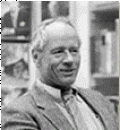U.S. Army
Ike’s son, historian John Eisenhower, recalls attending meetings with the British wartime leader and reflects on his character and accomplishments.
Nearly killed by a German bomb, Pyle faced the fear and frustration known as “Anzio anxiety” among the American soldiers trapped with him on the beach.
Allied soldiers struggled for months to clear veteran German troops dug into the mountains of northern Italy in late 1944 and early 1945.
J.D. Salinger carried a draft of his subsequently classic novel with him when he landed on the beach at Normandy.
Jan Scruggs fought on multiple fronts to build the Vietnam Memorial, which was once derided as a “black gash” and “Orwellian glop.” His work inspired a nation and helped bring Americans together.
Too often overlooked today, the New Guinea campaign was the longest of the Pacific War, with 340,000 Americans fighting more than half a million Japanese.
When Germany unleashed its blitzkreig in 1939, the U.S. Army was only the 17th largest in the world. FDR and George Marshall had to build a fighting force able to take on the Nazis, against the wishes of many in Congress.
The great war correspondent, who died 75 years ago during the battle of Okinawa, had a knack for connecting with everyday people, both on the front lines and at home.
The April 1969 issue was typical of classic issues of American Heritage, with dramatic and substantive essays on George Washington, Ike and Patton, the Transcontinental Railroad, the "ship that wouldn't die," and many other fascinating subjects from our nation's past
Seventy-five years ago, Allied soldiers made a daring amphibious landing behind German lines and were soon surrounded in what would become one of the toughest battles of World War II.
After World War I, Army Intelligence officers collected statements from German soldiers and citizens.
In October 1918, 600 men of the 77th Division attacked a heavily defended German position, charging forward until they were completely surrounded by enemy forces. Only 194 of these men survived.
A century after the guns fell silent along the Western Front, the work they did there remains of incalculable importance to the age we inhabit and the people we are.
A noted historian recalls how he came to learn about the five-star general who led American forces to victory in World War I, and the sacrifices made by his family.
In history’s long parade of military heroes, few can rival Sergeant Alvin C. York.
With his command threatened by allegations of drunkenness, Ulysses S. Grant went on the attack, won two major victories, demanded “Unconditional Surrender,” and nearly split the Confederacy in half.
Eisenhower's call to proceed with D-Day was anything but inevitable.
A largely accidental battle, pitting Robert E. Lee against George B. McClellan, became the single deadliest day in America's history and changed the course of the Civil War.
The author, who once served under General Patton and whose father, Dwight D. Eisenhower, was Patton's commanding officer, shares his memories of "Ol' Blood and Guts."
Debate over America's involvement in World War II came to a head in July 1941 as the Senate argued over a draft-extension bill. The decision would have profound consequences for the nation.
A preeminent author recalls his experience as one of America's first combat historians, among a handful of men who accompanied soldiers into the bloodiest battles to write history as it was being made.
A preeminent author recalls his experience as one of America's first combat historians, among a handful of men who accompanied soldiers into the bloodiest battles to write history as it was being made.
In 1817, “Old Pewt’s” rebellious cadets met their master in Sylvanus Thayer
A magazine reporter covered the first American deaths in Vietnam, unaware that the soon-to-explode war would mark America’s awakening to maturity.
A young man from Queens jumps into the thick of World War II intelligence activities by translating secret Japanese messages
The book that taught GI’s how to behave in England
How the U. S. military reinvented itself after the Vietnam disaster
A young GI in Germany during the Korean War making the journey from war to peace, and from enmity to friendship, finds, amid the most tremendous change, smoldering embers of an old tyranny.
The final hours of the war were every bit as perilous as all the other ones for this American POW.
Next to Winston Churchill, General George Patton gave the war’s most famous speeches. But nobody knew quite what he said—until now.





